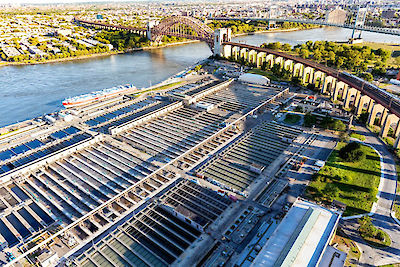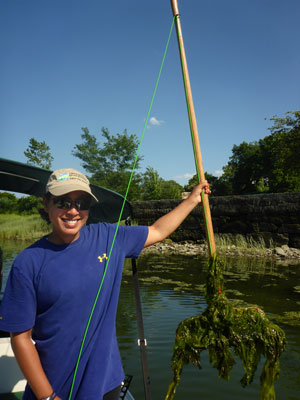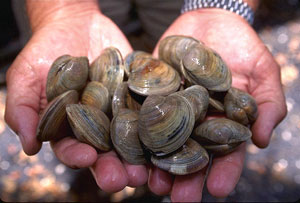 When New York and Connecticut built our sewage treatment plants decades ago, the public appreciated the reduction of fecal bacteria and other contaminants that allowed for swimming and sports, and harvesting of healthy shellfish. Considered less of a threat at the time was the devastating impact of high volumes of human-sourced nutrients on ecosystem health and the quality of life in coastal communities. By the 1980s, the steady increase in population and the nutrients excreted by humans into our toilet bowls caught up with Long Island Sound; traditional sewage treatment plants do not remove these nutrients. Harbors full of dying fish and shellfish, dirty beaches, and waters almost devoid of oxygen got the attention of the public and EPA. In 2000, EPA, New York State, and Connecticut agreed to make a significant investment in a clean and healthy Sound. More than two billion dollars were invested over the following 16 years to treat nitrogen at dozens of sewage treatment plants that discharge to the Sound—ultimately achieving a 58.5% reduction in the amount of nitrogen entering Long Island Sound from those plants. And it seems to be working! While ecosystems don’t change overnight, this Report Card shows how a coordinated investment in treating our sewage is improving water quality in the open waters of the Sound. Most importantly, dissolved oxygen—critical to sustaining aquatic life—is improving in the far western Sound. After decades, the low oxygen zone found in the Western Sound each summer is shrinking and fish die-offs are smaller and less frequent. Pressure from increasing human population, rising temperatures, and other ecosystem stressors requires that we continue to ratchet down on the amount of nitrogen entering the Sound from all sources, including fertilizers and the roughly 500,000 septic systems in coastal communities. Read on to learn how you can help!
When New York and Connecticut built our sewage treatment plants decades ago, the public appreciated the reduction of fecal bacteria and other contaminants that allowed for swimming and sports, and harvesting of healthy shellfish. Considered less of a threat at the time was the devastating impact of high volumes of human-sourced nutrients on ecosystem health and the quality of life in coastal communities. By the 1980s, the steady increase in population and the nutrients excreted by humans into our toilet bowls caught up with Long Island Sound; traditional sewage treatment plants do not remove these nutrients. Harbors full of dying fish and shellfish, dirty beaches, and waters almost devoid of oxygen got the attention of the public and EPA. In 2000, EPA, New York State, and Connecticut agreed to make a significant investment in a clean and healthy Sound. More than two billion dollars were invested over the following 16 years to treat nitrogen at dozens of sewage treatment plants that discharge to the Sound—ultimately achieving a 58.5% reduction in the amount of nitrogen entering Long Island Sound from those plants. And it seems to be working! While ecosystems don’t change overnight, this Report Card shows how a coordinated investment in treating our sewage is improving water quality in the open waters of the Sound. Most importantly, dissolved oxygen—critical to sustaining aquatic life—is improving in the far western Sound. After decades, the low oxygen zone found in the Western Sound each summer is shrinking and fish die-offs are smaller and less frequent. Pressure from increasing human population, rising temperatures, and other ecosystem stressors requires that we continue to ratchet down on the amount of nitrogen entering the Sound from all sources, including fertilizers and the roughly 500,000 septic systems in coastal communities. Read on to learn how you can help!
Water quality in your bay or harbor
 Ask a shoreline resident about the Sound and they’ll likely talk about their local harbor, cove, or bay. These inlets, or “embayments,” are often where people have the most direct and intimate contact with the Sound. Each is unique, with varying water quality influenced in large part by the conditions on the land that drains to the embayment, including the community’s infrastructure, and development patterns. Sadly, many of these embayments exhibit signs of ecosystem stress—algae blooms, low oxygen, and loss of desirable plants and animals. And research shows that these embayments do not all respond in the same way to Sound-wide management activity. Until recently we have not had a good measurement of how the 100+ embayments of Long Island Sound are faring in terms of environmental health, and how they compare with one another. Thanks to a Sound-wide community monitoring program launched in 2017, we are now gathering those data! The Unified Water Study is a collaborative network of monitoring groups, trained and coordinated by Save the Sound, which is following the same monitoring protocol in 36 embayments. The program spans the full length of Long Island Sound. Look for results from this monitoring program in future Report Cards.
Ask a shoreline resident about the Sound and they’ll likely talk about their local harbor, cove, or bay. These inlets, or “embayments,” are often where people have the most direct and intimate contact with the Sound. Each is unique, with varying water quality influenced in large part by the conditions on the land that drains to the embayment, including the community’s infrastructure, and development patterns. Sadly, many of these embayments exhibit signs of ecosystem stress—algae blooms, low oxygen, and loss of desirable plants and animals. And research shows that these embayments do not all respond in the same way to Sound-wide management activity. Until recently we have not had a good measurement of how the 100+ embayments of Long Island Sound are faring in terms of environmental health, and how they compare with one another. Thanks to a Sound-wide community monitoring program launched in 2017, we are now gathering those data! The Unified Water Study is a collaborative network of monitoring groups, trained and coordinated by Save the Sound, which is following the same monitoring protocol in 36 embayments. The program spans the full length of Long Island Sound. Look for results from this monitoring program in future Report Cards.
Learn more about the Unified Water Study: LIS Embayment Research at savethesound.org/unified-water-study
The bounty of Long Island Sound
 Long Island Sound is an estuary—one of the most productive types of ecosystems on Earth. It’s home to countless marine species including 170 known species of fish, as well as sea turtles, seals, whales, and dozens of species of migratory birds. The Sound and the natural areas draining to it are an economic engine providing approximately 200,000 jobs and ecosystem services valued at between $17 billion and $37 billion a year. Millions of people enjoy the Sound’s fresh fish and shellfish year-round, and the pleasure of open beaches every summer. Long Island Sound has 220+ beautiful beaches, more than half of which are open to the public. Continued investment in our sewage infrastructure is required to keep our beaches, and our shellfish, healthy and accessible for public enjoyment. Clean water is at the center of Long Island Sound’s productivity and shoreline residents’ quality of life!
Long Island Sound is an estuary—one of the most productive types of ecosystems on Earth. It’s home to countless marine species including 170 known species of fish, as well as sea turtles, seals, whales, and dozens of species of migratory birds. The Sound and the natural areas draining to it are an economic engine providing approximately 200,000 jobs and ecosystem services valued at between $17 billion and $37 billion a year. Millions of people enjoy the Sound’s fresh fish and shellfish year-round, and the pleasure of open beaches every summer. Long Island Sound has 220+ beautiful beaches, more than half of which are open to the public. Continued investment in our sewage infrastructure is required to keep our beaches, and our shellfish, healthy and accessible for public enjoyment. Clean water is at the center of Long Island Sound’s productivity and shoreline residents’ quality of life!
This Report Card does not include data or grades for fecal bacteria levels in Sound waters; however, in 2019 we will publish a LIS Beach Report. For historic data on the Sound’s beach water quality, visit SoundHealthExplorer.org.
